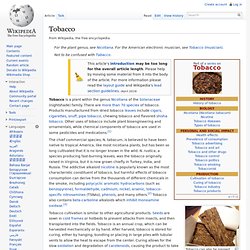

Kyle Czech
Organic chemistry. Pineal Gland. Nootropics. Questions. Nicotine. In smaller doses (an average cigarette yields about 1 mg of absorbed nicotine), the substance acts as a stimulant in mammals, while high amounts (50–100 mg) can be harmful.[5][6][7] This stimulant effect is likely to be a major contributing factor to the dependence-forming properties of tobacco smoking, nicotine patches, nicotine gum, nicotine inhalers and liquid nicotine vaporizers.

[citation needed] According to the American Heart Association, nicotine addiction has historically been one of the hardest addictions to break, while the pharmacological and behavioral characteristics that determine nicotine addiction are similar to those determining addiction to heroin and cocaine. The nicotine content of popular American-brand cigarettes has slowly increased over the years, and one study found that there was an average increase of 1.78% per year between the years of 1998 and 2005.
This was found for all major market categories of cigarettes.[8] Psychoactive effects[edit] Medical uses[edit] Tobacco. Tobacco can also be pressed into plugs and sliced into flakes.

The chief commercial species, N. tabacum, is believed to have been native to tropical America, like most nicotiana plants, but has been so long cultivated that it is no longer known in the wild. N. rustica, a species producing fast-burning leaves, was the tobacco originally raised in Virginia, but it is now grown chiefly in Turkey, India, and Russia. The addictive alkaloid nicotine is popularly known as the most characteristic constituent of tobacco, but harmful effects of tobacco consumption can derive from the thousands of different chemicals in the smoke, including polycyclic aromatic hydrocarbons (such as benzopyrene), formaldehyde, cadmium, nickel, arsenic, tobacco-specific nitrosamines (TSNAs), phenols, and many others.[2] Tobacco also contains beta-carboline alkaloids which inhibit monoamine oxidase.[3] Tobacco cultivation is similar to other agricultural products.
Supplements. Amphetamines. Psychedelics. Drug danger and dependence.